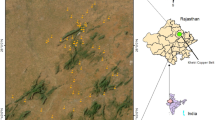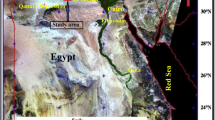Abstract
The concentration of naturally existing primordial radionuclides (238U, 232Th and 40K) in the soil at various locations in Coonoor, South India has been determined from the gamma spectrum of soil recorded using a low-background NaI(Tl) detector coupled to 8 K multichannel analyzer system. The average concentration of 238U, 232Th and 40K radionuclides in the soil has been found to be 41.5, 78.0 and 295.6 Bq kg−1, respectively. The mean concentration of 232Th and 238U estimated in the soil of the study area is found to be 2.6 and 1.2 times the corresponding value reported as the world average. The absorbed gamma dose rate in the air at 1 m above the soil due to these radionuclides has been calculated as 78.6 nGy h−1 and it is found to be 1.54 times the world average value. The radium equivalent activity (Raeq) of soil has been calculated and it is found to be 175.9 Bq kg−1. The external hazard index (H ex) and the internal hazard index (H in) of soil are estimated as 0.47 and 0.59, respectively. Raeq, H ex and H in of soil in the study area are found to be less than recommended level and it is safe to live in the study area. The variation in the activity concentration of primordial radionuclides with depth is also studied. It has been found that their concentration decreases with depth. The annual outdoor and indoor effective dose equivalent is found to be 96.45 and 385.79 μSv year−1, respectively.



Similar content being viewed by others
References
Arafa W (2004) Specific activity and hazards of granite samples collected from the Eastern desert of Egypt. J Environ Radioact 75(3):315–327
Arunkumar M, Gurugnanaran B, Venkataraman AT (2013) Topographic data base for landslides assessment using GIS in between Mettupalayam–Udhagamandalam highways, South India. Int J Innov Technol Explor Eng 2(5):302–306
Baeza A, Del Rio M, Miro C, Paniagua J (1994) Natural radionuclide distribution in soils of Caceres (Spain): dosimetry implications. J Environ Radioact 23(1):19–37
Beck HL (1972) The physics of environmental radiation field. Natural radiation environment II. CONF-720805 P2. In: Proceedings of the second international symposium on the natural radiation environment
Beretka J, Mathew PJ (1985) Natural radioactivity of Australian building materials, industrial wastes and by products. Health Phys 48(1):87–95
Caner L, Bourgeon G (2001) On the possibilities of palaeoenvironmental reconstitution offered by tropical highland andisols. Example of Nilgiri andisols (South India). Comptes Rendus de l’Academie des Sciences Series IIA Earth and Planetary Science 333:725–731
Chen CJ, Weng PS, Chu TC (1993) Evaluation of natural radiation in houses built with black Schist. Health Phy 64(1):74–78.
Deer WA, Howier RA, Zussman J (1997) Rock-forming minerals: orthosilicates. Geological Society, London
El-Arabi AM (2007) 226Ra, 232Th and 40K concentrations in igneous rocks from Eastern desert, Egypt and its radiological implication. J Radiat Meas 42(1):94–100
Hamilton EI (1971) The relative radioactivity of building materials. Am Ind Hyg Assoc J 32(6):398–403
Hannan MA, Nguyen NMR (2013) Natural radioactivity and its gamma dose rate in mission (Texas) soils. J Radioanal Nucl Chem 295(1):729–736
Iyengar MAR, Rajan MP, Ganapathy S, Kamath PR (1989) Sources of Natural Radiation Exposure in the Low Monazite Environment, In: Gessell TF, Lowder WM (eds) Natural Environment III Proc. Symp. on natural radiation environment iii, Houston, Texas: CONF-7050422. pp 1090–1106
Iyer MR, Iyengar MAR, Ganapathy S (1974) Radiation survey of monazite areas at Kalpakkam, India. BARC-I/315, Bhabha Atomic Research Center, Bombay, India. P 1–138
Kannan V, Rajan MP, Iyengar MAR, Ramesh R (2002) Distribution of natural and anthropogenic radionuclides in soil and beach sand samples of Kalpakkam (India) using hyper pure germanium (HPGe) gamma ray spectrometry. Appl Radiat Isot 57(1):109–119
Kerur BR, Rajeshwari T, Anilkumar S, Naryanai K, Rekha AK (2012) Gamma spectrometric analysis of ore samples from Sandur of Bellary, Karnataka India. J Radioanal Nucl chem 294(1):191–196
Kurnaz A, Kucukomeroglu B, Keser R, Okumusoglu NT, Korkmaz F, Karahan G, Cevik U (2007) Determination of radioactivity levels and hazards of soil and sediment samples in Firtina Valley (Rize, Turkey). Appl Radiat Isot 65(11):1281–1289
Miah FK, Roy S, Touchiduzzaman M, Alam B (1998) Distribution of radionuclides in soil samples in and around Dhaka city. Appl Radiat Isot 49(1–2):133–137
Mustapha AO, Patel JP, Rathore IVS (1999) Assessment of human exposures to natural sources of radiation in Kenya. Radiat Prot Dosimetry 82:285–292
Narayana Y, Radhakrishna AP, Somashekarappa HA, Karunakara N, Balak KM, Balakrishna K, Siddappa K (1995) Distribution and enrichment of radionuclides in the newly discovered high background area in Ullal on the Southwest coast of India. Health Phys 69(2):178–186
OECD (1979) Exposure to radiation from natural radioactivity in the building materials. Nuclear Energy Agency, Organisation for Economic Cooperation Development, Paris, France
Orgun Y, Altinsoy N, Gultekin AH, Karahan G, Celebi N (2005) Natural radioactivity levels in granite plutons and groundwater in Southeast part of Eskisehir, Turkey. Appl Radiat Isot 63(2):267–275
Orgun Y, Altinsoy N, Sahin SY, Gungor Y, Gultekin AH, Karahan G, Karacik Z (2007) Natural and anthropogenic radionuclides in rocks and beach sands from Ezine Region (Canakkale), Western Anatolia, Turkey. Appl Radiat Isot 65:739–747
Osburn WS (1965) Primordial radionuclides: their distribution, movement and possible effect within terrestrial ecosystems. Health Phys 11:1275–1295
Pandian SS, Sivakumar R, Manikandan MN, Meenakshisundaram V, Raghunath VM, Gajendran V (2000) Natural radionuclide distribution in soils of Gudalore (India). Appl Radiat Isot 52(2):299–306
Papp Z, Deso Z, Daroczy S (1997) Measurement of the radioactivity of 238U, 232Th 137Cs and 40K in soil using direct Ge(Li) gamma ray spectrometry. J Radioanal Nucl Chem 222(1–2):171–176
Quind’os LS, Fernandez PL, Soto J, R’odenas C, Comez J (1994) Natural radioactivity in Spanish soils. Health Phys 66:194–200
Radhakrishna AP, Somashekrappa HM, Narayana Y, Siddappa K (1993) A new natural background radiation area on the Southwest coast of India. Health Phys 65(4):390–395
Ramola RC, Choubey VM, Prasad Ganesh, Gusain GS, Tlosheva Z, Kies A (2011) Radionuclides analysis in the soil of Kumaun Himalayas, India, using gamma ray spectrometry. Curr Sci 100(6):906–914
Ridvan B, Sytekin H, Erer M (2011) Radioactivity measurements and radiation dose assessments due to natural radiation in Karabuk (Turkey). J Radioanal Nucl Chem 289:297–302
Shenber MA (1997) Measurement of natural radioactivity levels in soil in Tripoli. Appl Radiat Isot 48(1):147–148
Shetty PK, Narayana Y, Rajashekara KM (2011) Depth profile study of natural radionuclides in the environment of costal Kerala. J Radioanal Nucl Chem 290(1):159–163
Sunta LM, David M, Abani MC, Basu AS, Nambi KSV (1982) Analysis of dosimeter data of high natural radioactivity areas of South west coast of India. In: proc. Symp. On Natural radiation environment, Bombay, Wiley Eastern Ltc. And BARC. pp 35–42
Sutherland RA, de Jong E (1990) Statistical analysis of gamma emitting radionuclide concentrations for three fields in Southern Saskatchewan, Canada. Health Phys 58(4):417–428
Tchokossa P, Olomo JB, Balogun FA, Adesanmi CA (2012) Radiological study of soils in oil and gas producing areas in delta state Nigeria. Radiat prot Dosimetry 153(1):121–126
Tufail M, Ahmada N, Mirzaa SM, Mirzaa NM, Khanb HA (1992) Natural radioactivity from the building materials used in Islamabad and Rawalpindi, Pakistan. Sci Total Environ 121:283–291
Tzortzisa M, Tsertosa H, Christofidesb S, Christodoulidesb G (2003) Gamma-ray measurements of naturally occurring radioactive samples from Cyprus characteristic geological rocks. Radiat Meas 37(3):221–229
UNSCEAR (2000) Source and effects of ionizing radiation. United national scientific committee on the effects of atomic radiation. United Nations, New York
Yang HS, Nozaki Y, Sakai H, Nagaya Y, Nakamura K (1986) Natural and man-made radionuclide distributions in Northwest pacific deep-sea sediments: rates of sedimentation, bioturbation and 226Ra migration. Geochem J 20(1):29–40
Yu KN, Guan ZJ, Stokes MJ, Young EC (1992) The assessment of the natural radiation dose committed to the Hong Kong people. J Environ Radioact 17(1):31–48
Zubair M, Verma D, Azam A, Roy S (2013) Natural radioactivity and radiological hazard assessment of soil using gamma-ray spectrometry. Radiat Prot Dosimetry 155(4):467–473
Acknowledgments
The author gratefully acknowledges the guidance and encouragement given throughout the work by Dr. V. Meenakshisundaram, former Head Radiation Safety Section, Indira Gandhi Center for Atomic Research, Kalpakkam, India, Dr. V. Kannan, former Head Environmental Survey Laboratory, Kalpakkam, India and Dr. S.S. Pandian, Senior Professor, Kalasalingam University, Tamil Nadu, India. The author also thanks the administration of Jubail University College for support provided.
Author information
Authors and Affiliations
Corresponding author
Rights and permissions
About this article
Cite this article
Sivakumar, R. An assessment of natural radioactivity levels and radiation hazards in the soil of Coonoor, South India. Environ Earth Sci 72, 5063–5071 (2014). https://doi.org/10.1007/s12665-014-3375-6
Received:
Accepted:
Published:
Issue Date:
DOI: https://doi.org/10.1007/s12665-014-3375-6




